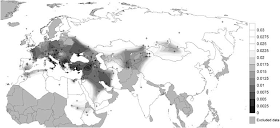
It is wonderful to see a sample from the medieval period, thanks to the Sagalassos division. The city of Sagalassos is in Pisidia (southwest Anatolia).
On the composition of the sample:
This work analysed 85 individuals excavated from two different locations: 57 skeletons were recovered from pits in the context of a slope composed of earthquake debris caused by a seismic event in the late 6th century AD, flanking the area of the ‘Lower Agora’, whereas 28 individuals were found in a neighbouring churchyard, within the adjoining ‘Apollo Klarios Shrine’.11 The archaeological context pointed to low social status burials that followed the Christian tradition (see Supplementary Text). All graves have been dated to the 11th–13th century cal AD by AMS carbon-14 dating of human bones (Analytic Inc. http://www.radiocarbon.com) and/or from the stratigraphical sequencing coupled with the general historical reconstruction of the site. DNA extractions were made from more than 169 bone and tooth samples from the 85 skeletons.This is a unique opportunity to look at a medieval Greek population of pre-Ottoman times. Unfortunately, the authors did not have a comparative modern Greek sample from West Asia Minor, but they did compare against a very large number of populations. Below is a figure of the Fst distances:
Nothing too surprising here, as the closest genetic distances seem to be overall with Anatolian, Balkan, and Italian populations. There is more information in the supplementary material, with the first few closest populations being Bulgarian, Turkey_East Anatolian, Turkey_Anatolian, Croatian, Central Greek, Ukrainian_Crimean, and Cyprus, i.e., regions with a well known Greek/Roman/Byzantine historical heritage.
The close relationship with modern Turkish populations is consistent with the idea of only a small Central Asian contribution to the Turkish population. However, we should use the mtDNA evidence with caution, as the Supplementary material reveals that the various Turkish samples have negative or small Fst with a number of different populations.
The relationship with the Ukrainian Tartars is the most interesting one, and the authors do a good job of uncovering the most probable reasons behind it:
As an additional issue, it should be noted that our results detected a genetic affinity with Crimean Tartars (Figure 2, 3). This affinity has to be considered with caution due to the small sample size (20 individuals), and the absence of historical records of interactions between this people and southwest Anatolia. Historically, the Crimea was colonized in the 7th and 6th centuries BC by Miletos, due to the increasing pressure of the Lydians and the loss of lands. During the earlier 1st century BC Crimea became part of Mithridates VI’s Pontic Kingdom.
All discovered sequences belonged to West Eurasian mtDNA lineages:
All Sagalassos sequences fall into a set of haplogroups within macrohaplogroups N (X, W and N1b) and R (R0a, H, V, HV, U, K, J and T) that are characteristic of West Eurasians. None of the sequences from Sagalassos belong to the East/South Asian macrohaplogroup M and subSaharan haplogroups (L1, L2 and L3A).
European Journal of Human Genetics doi:10.1038/ejhg.2010.230
Mitochondrial analysis of a Byzantine population reveals the differential impact of multiple historical events in South Anatolia
Claudio Ottoni et al.
The archaeological site of Sagalassos is located in Southwest Turkey, in the western part of the Taurus mountain range. Human occupation of its territory is attested from the late 12th millennium BP up to the 13th century AD. By analysing the mtDNA variation in 85 skeletons from Sagalassos dated to the 11th–13th century AD, this study attempts to reconstruct the genetic signature potentially left in this region of Anatolia by the many civilizations, which succeeded one another over the centuries until the mid-Byzantine period (13th century BC). Authentic ancient DNA data were determined from the control region and some SNPs in the coding region of the mtDNA in 53 individuals. Comparative analyses with up to 157 modern populations allowed us to reconstruct the origin of the mid-Byzantine people still dwelling in dispersed hamlets in Sagalassos, and to detect the maternal contribution of their potential ancestors. By integrating the genetic data with historical and archaeological information, we were able to attest in Sagalassos a significant maternal genetic signature of Balkan/Greek populations, as well as ancient Persians and populations from the Italian peninsula. Some contribution from the Levant has been also detected, whereas no contribution from Central Asian population could be ascertained.
Link


Interesting article, and a treasure trove of info on mtDNA!!!
ReplyDeleteI've been unsuccessfully searching for years for information on the distribution of my mtDNA T1 (actually T1a1), and finally found it here:
Frequency of T1 in Ireland: 1.33%
Top 10 locations for T1 by highest frequency:
1. Romania - 8.51%
2. Parsis (Pakistan) - 6.80%
3. Bulgaria - 6.38%
4. Portugal (Northern) - 6.38%
5. Azerbaijan - 6.25%
6. Armenia - 5.76%
7. Brahui (SW Pakistan) - 5.30%
8. Mazandarian (N Iran) - 4.8%
9. Macedonia - 4.5%
10. Pathan (NW Pakistan) - 4.5%
The close relationship with modern Turkish populations is consistent with the idea of only a small Central Asian contribution to the Turkish population.
ReplyDeleteBut wouldn't most of the Central Asian "contributors" have been male and therefore would not have passed on their mtDNA to their descendants?
Mongoloid mtDNA runs at about 5% in Turkey; there does not seem to be an imbalance of it like we observe in latin America
ReplyDeletehttp://dienekes.blogspot.com/2005/04/non-caucasoid-admixture-in-turks.html
Hmm......
ReplyDeleteThe highest levels of U5b are in the Basque (10.9%), Finns (9.92%) and Sardinians (8.1%). Lithuanians are not listed. As Finland and Sardinia seem to be different relict populations perhaps U5b is evidence of an even older underlay or common source.
Dropping to 5.58% in Norway, 5% in Ireland, and 5% in the Kurds according to Achilli (IrnK) but absent in other Kurdish populations. (Ignoring NESpain which has to be Basque overflow.)
I get Norway and Ireland as these lie at the outer limits of Europe, but I am thinking the U5b in Achilli Kurds might be an error/misallocation?